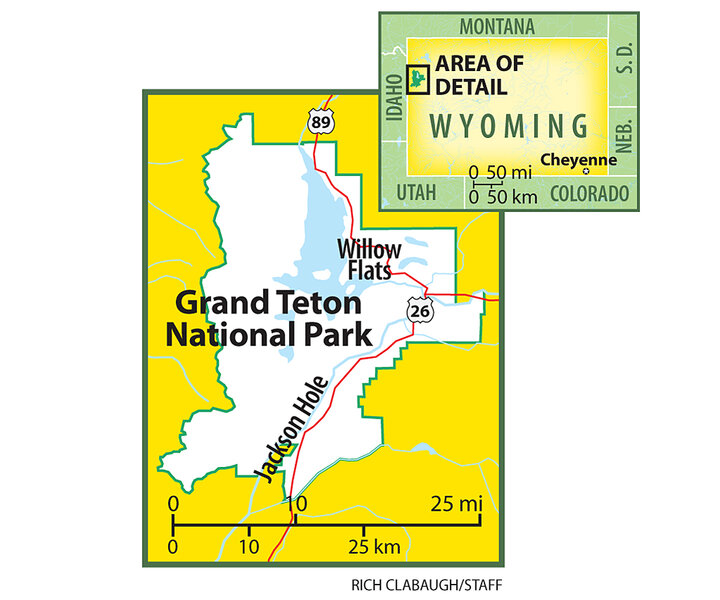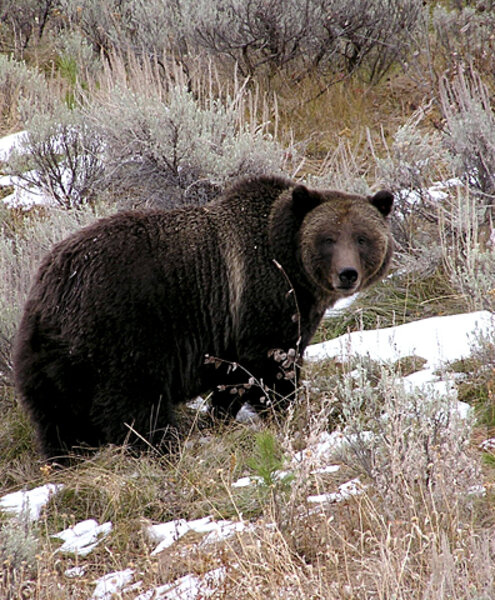For tourist and grizzly bear, a team of referees
Loading...
| Moose, Wyo.
It's just past suppertime on a sublime summer evening in the Wild West, and traffic on this rural highway leading toward Willow Flats, an area in the central part of Grand Teton National Park, is at a standstill. Like paparazzi staking out a starlet, photographers line the roadside, clutching formidable camera lenses. Tourists pour from cars, some climbing onto roofs to gain a better vantage.
More magnetic even than the backdrop of the Tetons, the cause of this commotion is a mother grizzly bear and three cubs. Right before vacationers' eyes, she is teaching her offspring how to hunt elk calves.
"These aren't just any bears," explains Thomas Mangelsen, a local nature photographer in Jackson Hole, Wyo. "They might be the most famous grizzlies alive today on the planet. For all these people, catching a glimpse of them is the thrill of a lifetime."
If there's a hard lesson from this summer's vacation season, though, it's that humans and bears don't necessarily mix. Here to preserve some semblance of order amid the threat of pandemonium (on the human side, at least) is a special legion called the Grand Teton Wildlife Brigade.
Their mission: keep humans, bruins, and other animals from harm – often from one another. Never have the citizen "brigaders" played a more vital role than they have this summer, says Grand Teton ranger Kate Wilmot, now that Grand Teton National Park's roadside grizzlies have become global sensations.
"We've gone from a somewhat chaotic atmosphere the last couple of years to a completely chaotic one now," says Ms. Wilmot, noting that social media have helped to spread the bears' fame. "My official title is 'bear management specialist,' but the real challenge is managing the behavior of people."
The brigade was created in 2007 when a grizzly sow named "399" – a numeric reference bestowed upon her by researchers – showed up along the national park's roadsides with three yearling cubs. She and her brood promptly attracted an international following – including Facebook fans and travelers making trips here just to see her.
Then came a bigger surprise. This spring 399 and another grizzly called "610" – 399's 5-year-old daughter – each emerged from her den with cubs. No. 399 had triplets at her side for the second time in half a decade, and 610 herself had twins in tow.
Wilmot oversees a corps of 16 volunteers who work until the snow flies. The youngest is Justin Schwabedissen, an Idaho college student. Reg and Laurie Wofford are retired septuagenarians from Hawaii.
"We're here because we love the parks," says Mrs. Wofford. "The payment we receive isn't money. It's the satisfaction of being able to do something meaningful."
Mama grizzlies, she notes, are notoriously protective of their offspring. Earlier this summer in Yellowstone National Park, a hiker was fatally mauled after surprising a mother bear and cubs along a trail. That incident, combined with two occasions in which Bear 610 charged Grand Teton tourists who got too close, prompted park officials to impose new viewing guidelines, mandating that tourists venture no closer than 100 yards.
"If the brigaders weren't there and wildlife watching were allowed to turn into a free-for-all, we'd have injured humans and bears, dangerous situations with motorists, and people throwing food out their car windows," says Wilmot. "It would be a mess."
The intent is to strike a balance between providing safe viewing opportunities and protecting the welfare of bears, she says.
The brigaders' role is akin to that of wildlife safari guides. But instead of packing guns, they are armed with canisters of bear spray and know-how about preventing hair-raising encounters. Several times they've stopped tourists from venturing within arm's length of bear mothers and cubs to take pictures with tiny point-and-shoot cameras, says ranger and brigade member Jolene Mohr.
"We get all kinds of wildlife-generated traffic congestion – elk jams, bison jams, moose jams. Last week there was even a beaver jam, but nothing compares to the bear jams," says Ms. Mohr. "It's been a challenging year, but we're loving the enthusiasm that people have."
A perennial problem is the illegal feeding of animals, which causes them to become habituated to people and often results in aggressive behavior. The aphorism "a fed bear is a dead bear" rings with truth, says park spokeswoman Jackie Skaggs. A few years ago, five black bears were euthanized after they developed a fondness for garbage.
"The wildlife brigade helps us address that problem by reminding tourists that they, in many ways, hold the fate of animals in their hands," she says. It's a testament to the brigade's success that, with tens of thousands of visitors observing the bears at relatively close range, there have been no major incidents or bear removals.
The saga of 399's extended clan has played out like a soap opera. In 2006, the matriarch mauled a hiker who wandered within range just after she had killed an elk. Rangers allowed her to live because the encounter was ruled self-defense and not her fault.
Two autumns ago, one of her offspring was shot by a big game hunter in the nearby Bridger-Teton National Forest, which is illegal because grizzlies are endangered species. Although the sportsman claimed self-defense, he was found guilty by a jury and fined.
Earlier this summer, another drama unfolded when 610 lost track of her cubs for 72 hours. She could be heard crying out for her offspring – causing human onlookers to empathize via text messages and tweets. The concern was that the cubs had fallen prey to a male grizzly, wolves, a mountain lion, or coyotes.
"I don't like to ascribe human traits to animals, but their reunion, when 610 finally reunited with her cubs, was joyous," says Mr. Mangelsen, who has spent much of the summer photographing them. "We all celebrated, too."
On this evening, as if choreographed, Bear 610 and her cubs sauntered in front of Jackson Lake Lodge, a park hotel, where hundreds of people gathered along a promenade to watch them prowl for elk calves against a backdrop of the Tetons.
"This is almost surreal it's so wonderful," Marilyn Hovland of Rapid City, S.D., who is leading a tour group of senior citizens through the park, tells a brigade member. "It's better than a nature documentary. It's better than Yellowstone."







